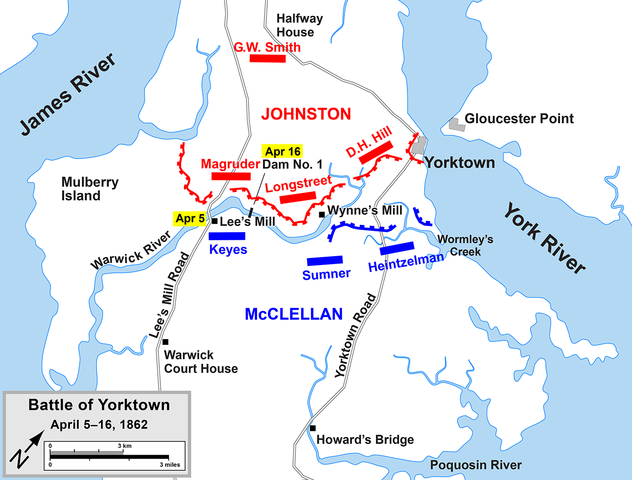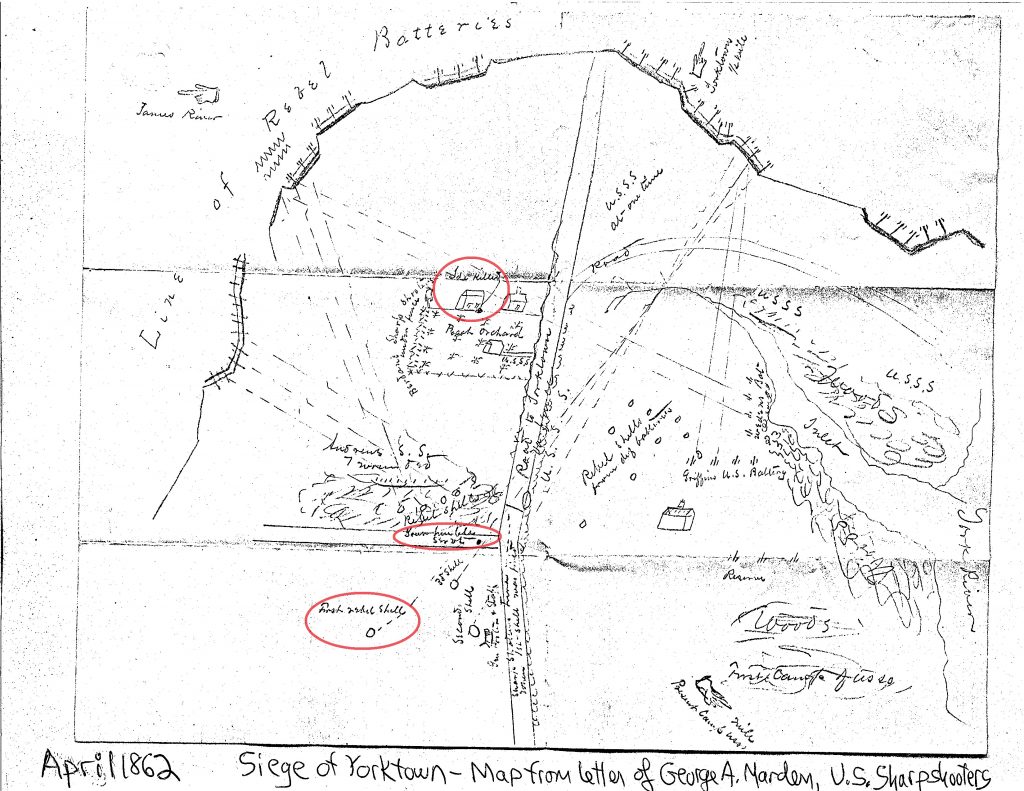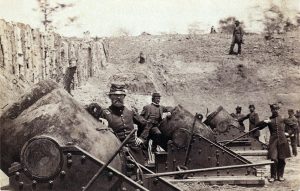Trial by Fire for the U.S. Sharpshooters at Yorktown, Part 2

Emerging Civil War welcomes back guest author Rob Wilson for Part 2 of his mini-series.
To read Part I of this series, about the U.S. Sharpshooters’ 1st Regiment and their role on first day of the Siege of Yorktown, click here.
Carefully choreographed Confederate cannon salvos and rifle fire greeted the Army of Potomac III Corps troops nearing Yorktown on April 5, 1862. “We were in exact range, and the rebels knew exactly what elevation it required to hit those cross roads, and could put the shells right to the spot,” remembered Pvt. Henry Harrington, one of the 1st Regiment U.S. Sharpshooters (U.S.S.S.) leading the column. While taking cover under a fence, Sgt. George Marden saw grisly proof of the enemy’s accuracy. “One Cavalry man got off his horse… and a cannon ball cut him into two and cut his horse’s jaw off,” he reported in a letter.[i]
The troops, engaged in Maj. Gen. George B. McClellan’s Peninsula Campaign, were marching to attack Richmond. But well-fortified Yorktown stood in their way. First Division Brig. Gen. Fitz John Porter ordered the men of the 1st U.S.S.S. ahead to probe and harass the enemy positions. They were deployed by the Sharpshooter’s leader, Lt. Col. Hiram Berdan, who, according to his official report, instructed the men “to guard the roads against cavalry… and to watch the movements of the enemy, and also in groups of from one to one hundred, to pick off gunners and protect batteries.” Meanwhile, Porter positioned federal artillery batteries and two brigades to return fire, screen for infantry and cavalry attacks and support the Sharpshooters.

The men of the 1st cautiously approached battlements that, noted Depew Swartout, were “built in the shape of a half moon,” providing Confederates an excellent field of fire. Incoming artillery fire mostly was high, but their foes “kept throwing shot from their fortifications with the Enfield rifle and musket,” he continued. The marksmen returned fire with their Colt 5-shot revolving rifles and highly-accurate target rifles, some creeping to just 400 yards from enemy positions.[ii]

Some Sharpshooters sheltered in a ditch to the right of the road to Yorktown. Others on the right positioned themselves near woods along Woolsey Creek (designated “Inlet” on Sgt. Marden’s map, above). On the left flank, a peach orchard, two abandoned houses and a fence afforded the soldiers cover. “[Two] companies with target rifles were up behind a fence and kept one fort still about three hours, by shooting the rebels as they came up to load,” Henry Harrington wrote, describing a U.S.S.S. tactic used very effectively during the siege. “The swab was put in one gun and no rebel dared go and get it for about two hours.”
Yorktown’s defenders, Harrington noted, gave as good as they got: “The boys [in the peach orchard] say that it gave them a queer feeling to hear the rifle balls ‘pat’ ‘fizz’ into the peach trees only a few feet from them.” Sheltered on the left, in a house near the peach orchard, William Wells and his Company F comrades were driven away when “bullets from the rebel rifle-pits on the left got to whizzing about our ears pretty thick.”[iii]
One of those bullets struck U.S.S.S. Private John Ide in the head. Ide, in Company E, was the first Sharpshooter to be killed on the campaign, and some of his comrades’ letters recounted the death and how the regiment’s second-in-command avenged it. “Lieut. Col. [William Y.W.] Ripley, who stood near, caught up the fallen man’s rifle, and before the rebel [who had shot Ide] could get back to the pit, put the ball through him,” one soldier wrote.
Company F moved right of the road and lay low, reported Wells, with “the balls and shells tearing through the air over our heads.” Describing the kind of wily maneuvering repeated all day and during future U.S.S.S. engagements, he wrote that some managed “stealing away on the sly to get a crack at the rebels.”[iv]

The federal units, backed by artillery, fought through the afternoon, firing on positions on the fortifications and engaging infantry and sharpshooters sheltered in rifle pits outside the Confederate’s defensive earthworks. As the artillery fire continued, one 1st Regiment man was surprised to be able to see some incoming rounds. “One 32 pounder burst in the air and a piece… whined along 50 ft. above me in plain sight,” he wrote. At one point, cavalry rode from behind the enemy’s fortifications to attack the Sharpshooters along the road and cut off their comrades in the orchard, remembered Capt. C.A. Stevens, “[but] a Union shell exploded in their midst and scattered them hurriedly, while well-aimed rifle bullets helped to hurry them back to cover.”
Early that evening the fighting took a sudden and unexpected turn. As Marden described the event, which was reported in other Sharpshooter letters and diaries, “…the sun [over Yorktown’s fortifications] got round so that our men could not see to fire at the rebels.” Most of the guns fell silent and, to the Yankee’s amazement, the Confederates “got out a band and played Dixie and the Marsellaise” from behind the earthworks.” The brief peace ended abruptly, he continued, when the Southerners suddenly “gave a cheer and immediately shot their shells booming into the S.S.” Incensed, Col. Berdan ordered men into a field to return fire. The move proved costly when “a volley of grape wounded seven… [and] the company double-quicked back,” wrote Marden. “At this the rebels jumped upon the parapets and commenced to cheer.”[v]

The Union side responded. It was back to the business of war.
Officers praised the performance of federal infantry and artillerymen engaged that day, directing special accolades to the Sharpshooters. On behalf of Porter, a staff officer issued a letter to Berdan, commending the regiment’s marksmanship and bluntly asserting: “Your men have caused a number of the enemy to bite the dust.” Yorktown’s defenders also received compliments. “There never was better firing than was done by the rebels that day,” observed Harrington. Another Sharpshooter, rattled by the continual cannon and rifle, wrote that he “did not think half of us would come off the field alive.” Yet the enemy’s big guns could not aim low enough to hit men close to the battlements and a very high number of their shells were duds, some actually plowing under soldiers without harming them. As a result, only two 1st Regiment men were killed. According to Porter’s official report, the day’s casualties for the 1st Division were four killed and 31 wounded.[vi]
Some of those new to an intense artillery bombardment wrote they were not eager to repeat the experience. “I never can get used to the whistle of a shell and hope that I shall not have to take the same position that I had Saturday while I am in the service,” Cyrus Hardaway of Company D declared. “The position that we held all day [400 yards from the battlements] has made lions of the Sharp Shooters but I had rather not be a lion than go through with it again.” At least one man was critical of sending a small force against such well-protected and positioned guns. Depew Swartwout, who had survived “minie bullets [that] came pattering like hail stones” on his forward position, reflected in his diary on those wounded and killed in the fighting and wrote “I thought it was rather a bad waste.”
That night, McClellan decided his next moves. His second troop column, on the road further to the south, had encountered the defensive line running across the peninsula, much of it on the dammed and flooded Warwick River. Observers there cautioned against a frontal attack. Believing his enemy had significant troop strength, the general opted for siege tactics, calling up his big guns from Ft. Monroe. In reality, the men in Gen. McClellan’s two troop columns that day vastly outnumbered the 15,000 Confederates spread thin along their 16-mile-long Warwick Line.[vii]

The Sharpshooters’ initial combat trial had ended and, by all accounts, the men had acquitted themselves well. The two sides cared for their wounded and buried their dead, the 1st U.S.S.S. mourning, Private Ide and Private David Phelps of Company H, who was mortally wounded by shrapnel. The business of April 5 was not entirely concluded, however. A Sharpshooter from Ide’s home state of New Hampshire would compose a long letter to his slain comrade’s home town newspaper. More than a note of condolence, the letter was written to praise Ide’s soldierly virtues and to assure Ide’s family and community that their soldier had served his country well and died an honorable death, the kind of “good death” that was such an important facet of Civil War-era society. [viii]
To be continued…
Sources:
[i] Henry Harrington, April 13, 1862 letter to the Cherry Valley Gazette (NY State Historical Association archives, Cooperstown, NY) [n.b.: Unless otherwise indicated, all correspondence and other soldiers’ writing quoted in this article dates to 1862); George Marden, Civil War letters, April 6 (Rauner Special Collections Library archives, Dartmouth College, Hanover N.H.).
[ii] Official Report of April 4-21, 1862 of Col. Hiram Berdan, Comdg. First United States Sharpshooters, April 21, 1862, in War of the Rebellion: Official Records of the Union and Confederate Armies in the War of the Rebellion, Series I, Vol. 3, Part I, ed. The National Historic Society (Washington, D.C.: Government Printing Office, 1880-1901), 301-302; Official Report of Brig. Gen. Fitz John Porter, U. S. Army, commanding division, of operations April 4—6, submitted April 23, in War of the Rebellion: Official Records of the Union and Confederate Armies in the War of the Rebellion, Series I, Vol. 11, Part I, ed. The National Historic Society (Washington, D.C.: Government Printing Office, 1880-1901), 285-286; Capt. C.A. Stevens, Berdan’s United States Sharpshooters In The Army Of The Potomac (St. Paul, Minn.; The Price McGill Company, 1892, reprinted by Old South Books), 37-44, Depew Swartwout, Co.D, 1st USSS, 1862 Diary entry (private collection).
[iii] Harrington, April 13; William Wells, Co. F, 1st USSS, April 6, 1862 letter to the Green Mountain Freeman, Apr. 22 issue (https://chroniclingamerica.loc.gov/lccn/sn84023209/).
[iv] Stevens, 41; Harrington, April 13 [There are differing versions of the story of exacting revenge for Pvt. Ide’s death. Although the details slightly differ, all the letters I reviewed were clear that the enemy rifleman who shot Ide was killed or wounded by a rifle shot, and all but one version attribute U.S.S.S. Lieut. Col. Ripley with pulling the trigger. Ripley would be wounded later in the campaign at Malvern Hill and would be awarded a Medal of Honor for his valor that day.]; William Wells, April 6.
[v] Stevens, 40; Marden, April 6 [Other soldiers at Yorktown on April 5 also reported the Confederate band concert that interrupted the fighting for a surreal moment.]
[vi] vi A.A.G. Fred T. Locke (in a letter written for Gen. Porter), April 8, published in The National Eagle, Claremont, N.H., April 24; Harrington, April 13; J.B. Delbridge, letter published in the Wolverine Citizen, April 19 (Michigan State University Library, Lansing, Michigan); Porter, April 23 report in the OR.
[vii] Cyrus Hardaway, Co. D, 1st USSS, April 8, 1862. http://external.oneonta.edu/unadilla/civil_war_letters/letters/images.asp (Used with the permission of G. William Beardslee). Swartwout, Diary entry; Stephen Sears, To the Gates of Richmond: The Peninsula Campaign (New York: Ticknor & Fields, 1992) 40-43.
[viii] Drew Gilpin Faust, This Republic of Suffering: Death and the American Civil War (New York; Alfred A. Knoph, 2008), 7-8.
1 Response to Trial by Fire for the U.S. Sharpshooters at Yorktown, Part 2